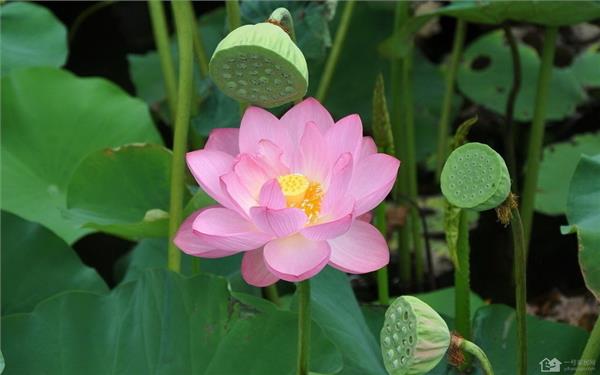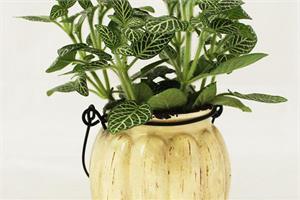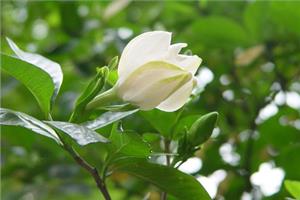The growth habit of Lotus how to grow Lotus in potted Plant
Lotus, also known as lotus, water hibiscus, etc., belongs to the order Nelumbo nucifera, lotus family perennial aquatic herbaceous flowers. The underground stem is long and thick, with long nodes, that is, I often say lotus root, leaf shield round, florescence from June to September. There are many kinds of lotus, which can be divided into two categories: ornamental and edible, lotus all over the body, lotus root and lotus seed can be eaten, lotus seed, rhizome, lotus root node, lotus leaf, flower and seed germ can be used as medicine.

Growth habits of lotus:
Lotus is native to tropical and temperate regions of Asia and is an aquatic plant. It is suitable for calm shallow water, lakes, marshes and ponds where it is relatively stable. The lotus is very sensitive to water loss. The lotus leaves planted in the water tank will wither as long as they are not irrigated for 3 hours in summer. if the water stops for one day, the lotus leaves will scorch and the buds will wither. The lotus also likes light very much and needs full light during its growth period. The lotus is extremely intolerant to shade and will show a strong phototaxis when it grows in the semi-shade.
How to grow potted lotus:
Lotus likes warmth and sunshine, avoid yin and bitter water, but like stable still water. Avoid dry, avoid deep water, hate the flowing water with great disparity in fluctuation. Suitable for humus-rich and slightly sticky soil, do not like loose sandy soil. Afraid of the cold, branches and leaves withered in autumn and winter, but the underground stem (lotus root) can survive the winter without freezing water. Generally 8-10 ℃ germination, 14 ℃ lotus root growth, high temperature flowering, 25 ℃ growth of new lotus root.
Culture methods of potted lotus:
1. Soil quality: Lotus requires fertile clay loam rich in humus. Excessive clayey soil affects the elongation of lotus root and the expansion of lotus root; easy soil is vulnerable to wind damage and hinders root development, which is not conducive to the growth of lotus. The soil is usually lake and pond mud, and it can also be mixed with 4 parts of garden soil, 3 parts of loess and 3 parts of sand. PH6.5~7.5 is the best soil.
2. Lighting: the lotus likes strong light and receives 7-8 hours of light every day, which can make its buds more, flowers bloom continuously, do not cultivate in shade, and indoor viewing can not exceed the same day when seeing flowers. The lotus is raised in the family pot. Be sure to put it on the balcony or in the courtyard and move to a shady place at noon to avoid the scorching sun.
3. Temperature: the lotus is very strict on the degree of depression, generally 8: 10 ℃ begins to sprout, 14 ℃ lotus root begins to elongate, 25: 30 ℃ is the most suitable temperature for lotus growth and development, especially in rainy and sunny weather is more conducive to plant growth.
4. Fertilization: the lotus is cultivated in the pot, and the chicken manure in the range of 200 to 500g is applied as the base fertilizer according to the size of the pot. the lotus cultivated with this fertilizer is better than pig manure, cow manure and human manure as the base fertilizer. One month after planting, you can put rotten bean cake water or human feces and urine-based liquid fertilizer at a concentration of 10%. After the standing leaves were produced, they were topdressing for 1 or 2 times, and superphosphoric acid was applied every 7 days during flowering.
5. Moisture: the lotus is easy to lose water when the temperature is high in summer. Therefore, the pot should add water once every two days, and the pot should add water once or twice a day, which should be roughly the same as the water temperature in the pot, and keep the water clean. If the water is found to be dirty, change the water. At the end of autumn and the beginning of winter, the lotus enters the dormant period, it is not necessary to add water frequently, only shallow water can be kept in the cylinder basin.
6. Diseases and insect pests: the common lotus pests are aphids on floating leaves or small standing leaves and Spodoptera litura from July to August. It can be sprayed with 50% dimethoate emulsion 1500-2000 times or 2.5% fish rattan essence 500 times.
In a word, doing a good job of management is an important part of growing lotus. No matter whether you apply water or fertilizer, you must remember not to overdo it. Although lotus is an aquatic plant and cannot be short of water, too much lotus will rot to death. Lotus is also a fertilizer-loving plant, but too much fertilizer will be counterproductive.
Related
- Wuhan Hospital Iron Tree Blooming Result Was Instantly Frightened by the Gardener Master
- Which variety of camellia is the most fragrant and best? Which one do you like best?
- What is the small blue coat, the breeding methods and matters needing attention of the succulent plant
- Dormancy time and maintenance management of succulent plants during dormancy
- Minas succulent how to raise, Minas succulent plant pictures
- What are the varieties of winter succulent plants
- How to raise succulent plants in twelve rolls? let's take a look at some experience of breeding twelve rolls.
- Attention should be paid to water control for succulent plants during dormant period (winter and summer)
- Watering experience of twelve rolls of succulent plants
- Techniques for fertilizing succulent plants. An article will let you know how to fertilize succulent plants.



